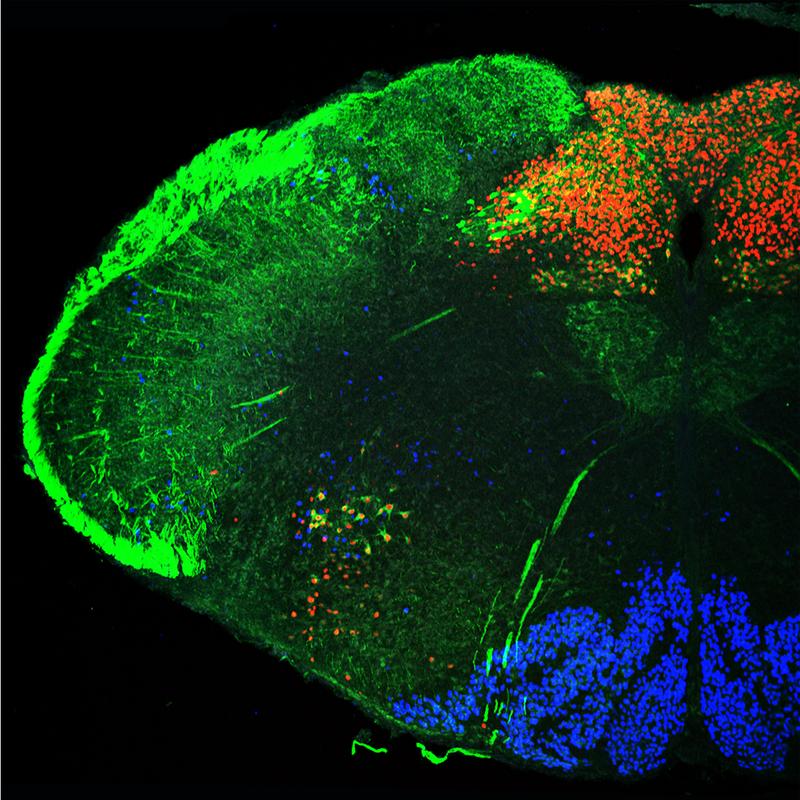

Transverse section of the hindbrain with the cells of the nucleus of the solitary tract visualized in red. These cells are essential for vocalization.
Image: Luis Hernandez-Miranda, MDC
The calls of new-born mice draw the attention of their mother. A group of neuronal cells in the brain stem is essential for this process. Without these cells, the mice are mute. These are the results of a study by a research team at the Max Delbrück Center in Berlin, which appears in the journal PNAS. The cries of human babies may well depend on similar connections, which could also be impaired in speech disorders.
Almost immediately after birth, mouse pups that are separated from their mother are able to make calls that summon her. The generation of these calls requires the coordinated activity of two muscle groups. This is achieved by neurons in a very old part of the brain, the brainstem, according to a study by Carmen Birchmeier's lab at the Max Delbrück Center for Molecular Medicine in the Helmholtz Association (MDC). Important contributions to the interdisciplinary study were made by the labs of Jean Champagnat in Paris and Gilles Fortin at the CNRS in Gif sur Yvette.
In series of experiments, the researchers have shown that the cells of the nucleus tractus solitarii (NTS) are linked to cells that control tension in the abdominal muscles and the vocal folds in the larynx. The nucleus also receives sensory information from the vocal folds, the tongue and the lung. During vocalization, it coordinates sensory inputs and motor outputs. However, if the genes for the transcription factors Olig3 or Tlx3 are mutated, the nerve cells in this particular nucleus cannot mature properly in the fetus. Without it, the pups cannot vocalize after birth.
The mother ignores mute offspring
Newborn mice need to be close to their mother and indicate this to her. As soon as a newborn mouse pup escapes the safety of the nest it emits salvos of four to six calls with a frequency of 75 kHz. These sounds are not audible to the human ear. During each call, the newborn mouse exhales deeply. The mother of the mouse, however, responds immediately: she goes looking for her lost progeny and reunites it with the rest of the litter. Even when she hears recorded ultrasound calls, she sets off in pursuit. If a baby mouse in distress is unable to emit these calls, the mother ignores it.
“We suspect that the calls are an evolutionarily conserved signal that indicates the offsprings' fitness and health,” Carmen Birchmeier says. “The mute mice are also a model for investigating the importance of vocalization for the interaction between mother and baby,” first-author Luis Hernandez-Miranda says.
Another idea is that the nucleus could be involved in the development and manifestation of speech disorders, which are often seen in patients after strokes, those who have a tumor or are suffering from neurodegenerative diseases.
Since 2007, Prof. Carmen Birchmeier is member of the Cluster of Excellence NeuroCure and since 2016 a member of the Einstein Center for Neurosciences Berlin.
Luis Rodrigo Hernandez-Miranda et al. (2017): “Genetic identification of a hindbrain nucleus essential for innate vocalization.” PNAS. doi:10.1073/pnas.1702893114
The Max Delbrück Center for Molecular Medicine (MDC)
The Max Delbrück Center for Molecular Medicine in the Helmholtz Association (MDC) was founded in Berlin in 1992. It is named for the German-American physicist Max Delbrück who was awarded the 1969 Nobel Prize in Physiology and Medicine. The MDC’s mission is to study molecular mechanisms in order to understand the origins of disease and thus be able to diagnose, prevent and fight it better and more effectively. In these efforts the MDC cooperates with the Charité – Universitätsmedizin Berlin and the Berlin Institute of Health (BIH) as well as with national partners such as the German Center for Cardiovascular Research and numerous international research institutions. More than 1,600 staff and guests from nearly 60 countries work at the MDC, just shy of 1,300 of them in scientific research. The MDC is financed by the Federal Ministry of Education and Research (90 percent) and the State of Berlin (10 percent) and is a member of the Helmholtz Association of German Research Centres. http://www.mdc-berlin.de/
https://www.mdc-berlin.de/1156809 – Website of Carmen Birchmeier’s lab
https://www.mdc-berlin.de/1156809/en/research/research_teams/developmental_biolo… – in-depth article on this paper on MDC website „Insights“












